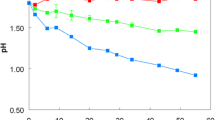Summary
The growth of Thiobacillus neapolitanus strain C in liquid cultures was depressed by phenylalanine, p-fluorophenylalanine, cysteine, methionine, nor-leucine, azetidine-2-carboxylic acid, and chloramphenicol, but was little affected by glutamic acid, glycine, proline, azathymine, or oligomycin.
Growing cultures assimilated 14C-labelled glycine, glutamic acid, phenylalanine, and tyrosine into protein. Tyrosine and phenylalamine were incorporated unchanged, but glutamate was used also for synthesis of arginine and proline. Glycine-14C contributed also to adenine and guanine synthesis. The extremely large amounts of phenylalanine incorporated into protein could indicate its toxicity to depend on its producing abnormal protein synthesis. Azetidine-2-carboxylic acid appeared to lower the amount of proline in the protein.
Assimilation of glutamate and glycine by non-growing organisms was almost entirely dependent on energy from thiosulphate oxidation, thus suggesting a cause of obligate chemoautotrophy. Chloramphenicol specifically inhibited this thiosulphate-dependent incorporation of glutamate, glycine or CO2 into protein at concentrations which did not affect total CO2-fixation. Provided that energy is available from thiosulphate-oxidation this Thiobacillus is thus able to (a) activate exogenous amino acids; (b) incorporate them and CO2 into protein by a chloramphenicol sensitive mechanism; (c) synthesise proline and arginine from glutamate; or adenine and guanine from glycine. Its biosynthesis thus depends on mechanisms like those of heterotrophs but requires to be driven by a chemolithotrophic energy supply.
Similar content being viewed by others
References
Butler, R. G., and W. W. Umbreit: Absorption and utilization of organio matter by the strict autotroph, Thiobacillus thiooxidans, with special reference to aspartic acid. J. Bact. 91, 661–666 (1966).
Clark, C., and E. L. Schmidt: Effect of mixed culture on Nitrosomonas europaea simulated by uptake and utilization of pyruvate. J. Bact. 91, 367–373 (1966).
Davies, J. W., and E. C. Cocking: Liquid scintillation counting of 14C and 3H samples using glass-fibre or filter-paper discs. Biochim. biophys. Acta (Amst.) 115, 511–513 (1966).
Delwiche, C. C., and M. S. Finstein: Carbon and energy sources for the nitrifying autotroph Nitrobacter. J. Bact. 90, 102–107 (1965).
Fowden, L.: Amino-acid analogues and the growth of seedlings. J. exp. Bot. 14, 387–398 (1963).
—, and M. H. Richmond: Replacement of proline by azetidine-2-carboxylic acid during biosynthesis of protein. Biochim. biophys. Acta (Amst.) 71, 459–461 (1963).
Ida, S., and M. Alexander: Permeability of Nitrobacter agilis to organic compounds. J. Bact. 90, 151–156 (1965).
Johnson, C., and W. Vishniac: Personal Communication from Corinne Johnson (1965).
Kelly, D. P.: Assimilation of organic compounds by a strictly chemoautotrophie Thiobacillus. J. gen. Microbiol. 41, v (1965).
Kelly, D. P.: Influence of organic compounds on Thiobacillus. Biochem. J. 100, 9P (1966).
—, and P. J. Syrett: The effect of uncoupling agents on carbon dioxide fixation by a Thiobacillus. J. gen. Microbiol. 34, 307–317 (1964).
——: [35S] Thiosulphate oxidation by Thiobacillus strain C. Biochem. J. 98, 537 to 545 (1966).
Krulwich, T. A., and H. B. Funk: Stimulation of Nitrobacter agilis by biotin. J. Bact. 90, 729–733 (1965).
Roberts, R. B., P. H. Abelson, D. B. Cowie, E. T. Bolton, and R. J. Britten: Studies of biosynthesis in Escherichia coli. Carnegie Institution of Washington Publication 607. Washington, D.C. (1955).
Smith, I.: Chromatographic and electrophoretic techniques, vol. I. London: W. Heinemann 1960.
van Niel, C. B.: The chemoautotrophic and photosynthetic bacteria. Ann. Rev. Microbiol. 8, 105–132 (1954).
Wilson, A. T., and M. Calvin: The photosynthetic cycle. CO2-dependent transients. J. Amer. chem. Soc. 77, 5948–5957 (1955).
Wolfe, M.: The quantitative determination of amino acids by paper chromatography. A solvent to replace phenol. Biochim. biophys. Acta (Amst.) 23, 186 to 191 (1957).
Author information
Authors and Affiliations
Rights and permissions
About this article
Cite this article
Kelly, D.P. Influence of amino acids and organic antimetabolites on growth and biosynthesis of the chemoautotroph Thiobacillus neapolitanus strain C. Archiv. Mikrobiol. 56, 91–105 (1967). https://doi.org/10.1007/BF00408761
Received:
Issue Date:
DOI: https://doi.org/10.1007/BF00408761



